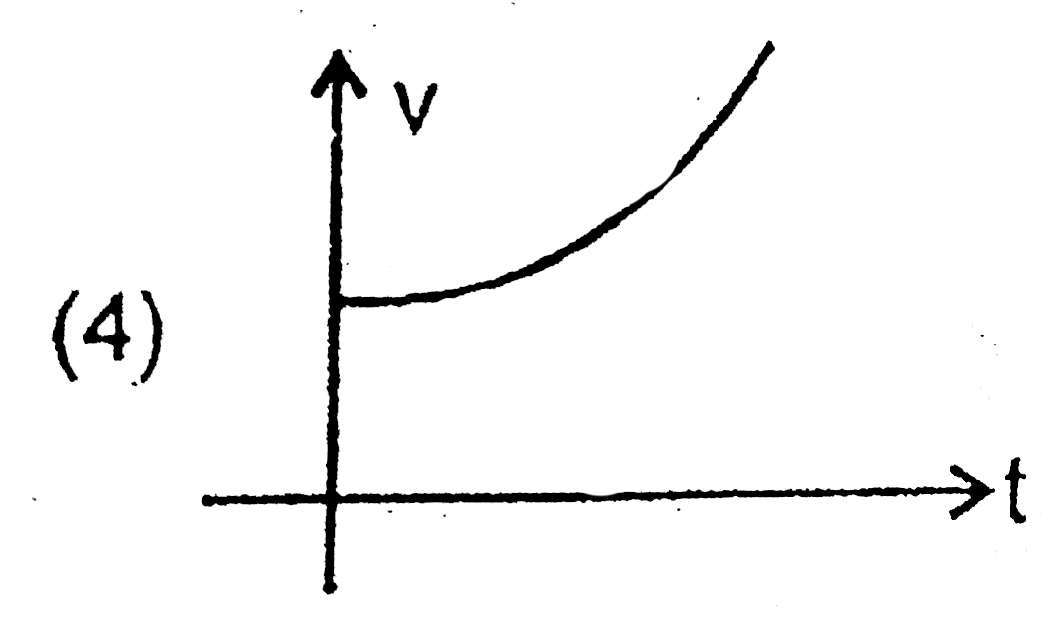If a stone is relased from a balloon moving upwards with certain velocity v0 at certain height above earth's surface then velocity time curve of stone's motion can be best represented by : (g = constant)




The correct Answer is:B
To solve the problem, we need to analyze the motion of the stone after it is released from the balloon. Here’s a step-by-step breakdown of the solution:
Step 1: Understand the Initial Conditions
When the stone is released from the balloon, it has an initial upward velocity v0 (the same velocity as the balloon).
Hint: Remember that the stone will initially continue moving in the direction it was moving at the moment of release.
Step 2: Identify the Forces Acting on the Stone
Once the stone is released, the only force acting on it is gravity, which pulls it downward with an acceleration g.
Hint: The stone is no longer influenced by the balloon's motion after release; it is now in free fall.
Step 3: Analyze the Motion of the Stone
The stone will first move upward (since it has an initial upward velocity v0), but as it ascends, the gravitational force will decelerate it until it reaches a maximum height where its velocity becomes zero.
Hint: The stone's upward motion will continue until the gravitational force counteracts its initial velocity.
Step 4: Determine the Velocity-Time Relationship
1. Upward Motion: The stone will move upward until it reaches its maximum height. During this phase, its velocity decreases from v0 to 0.
2. Downward Motion: After reaching the maximum height, the stone will start falling back down, gaining speed in the downward direction (negative velocity).
Hint: The velocity-time graph will show a decrease in velocity to zero and then a negative velocity as the stone falls back down.
Step 5: Sketch the Velocity-Time Curve
The velocity-time curve will start at v0, decrease linearly to 0 (at the maximum height), and then continue to decrease into negative values as the stone falls back down.
Hint: Since the acceleration due to gravity is constant, the velocity-time graph will be a straight line with a negative slope after the stone reaches its maximum height.
Conclusion
Based on the analysis, the velocity-time curve of the stone's motion can be best represented by option 2, which shows a positive initial velocity that decreases to zero and then becomes negative.
Final Answer: The correct representation of the velocity-time curve is option 2.
When the stone is released from the balloon, it has an initial upward velocity v0 (the same velocity as the balloon).
Once the stone is released, the only force acting on it is gravity, which pulls it downward with an acceleration g.
The stone will first move upward (since it has an initial upward velocity v0), but as it ascends, the gravitational force will decelerate it until it reaches a maximum height where its velocity becomes zero.
1. Upward Motion: The stone will move upward until it reaches its maximum height. During this phase, its velocity decreases from v0 to 0.
2. Downward Motion: After reaching the maximum height, the stone will start falling back down, gaining speed in the downward direction (negative velocity).
The velocity-time curve will start at v0, decrease linearly to 0 (at the maximum height), and then continue to decrease into negative values as the stone falls back down.
Based on the analysis, the velocity-time curve of the stone's motion can be best represented by option 2, which shows a positive initial velocity that decreases to zero and then becomes negative.
Topper's Solved these Questions
- TEST PAPERSBOOK - RESONANCE ENGLISHCHAPTER - TEST PAPERSEXERCISE - PART - II PHYSICS
106 Videos
- SIMPLE HARMONIC MOTION BOOK - RESONANCE ENGLISHCHAPTER - SIMPLE HARMONIC MOTION EXERCISE - Advanced Level Problems
13 Videos
- TEST SERIESBOOK - RESONANCE ENGLISHCHAPTER - TEST SERIESEXERCISE - PHYSICS
130 Videos
Similar Questions
A ball is projected upwards from a height h above the surface of the earth with velocity v. The time at which the ball strikes the ground is
View SolutionA ball is projected upwards from a height h above the surface of the earth with velocity v. The time at which the ball strikes the ground is
View SolutionA particle is thrown with escape velocity ve from the surface of earth. Calculate its velocity at height 3 R :-
View SolutionA stone is dropped from a balloon ascending with v0=2ms, from a height h=4.8 m .Find the time of flight of the stone.
View SolutionA packet is dropped from a balloon rising up with uniform velocity 9.8ms−1. If the balloon is at a height of 39.2 m from the ground at the time of dropping the stone, the stone reaches the ground after
View SolutionA particle is thrown vertically upwards with a velocity v. It returns to the ground in time T. which of the following graphs correctly represents the motion ?
View SolutionA balloon from rest accelerates uniformly upward with 'a' ms−2, for t seconds of time. A stone is released from the balloon. Now, read the following statements to pick the right ones.
(a) The stone's initial velocity is zero, relative to balloon
(b) The stone's initial velocity is nonzero, relative to earth
( c) The time taken to reach the ground from the balloon's frame of reference is inversely proportional to √(a+g)
(d) The time take to reach the ground from earth's frame of reference is directly proportional to √(a+g)
View SolutionA man in a balloon throws a stone downwards with a speed of 5m/s with respect to balloon. The balloon is moving upwards with a constant acceleration of 5m/s2. Then velocity of the stone relative to the man after 2 seconds is.

View SolutionA ball is thrown vertically upward with a velocity u from balloon descending with a constant velocity v. The vall will pass by the balloon after time
View SolutionA stone is dropped from a balloon going up with a uniform velocity of 5.0 m/s. If the balloon was 50 m high when the stone was dropped, find its height when the stone hits the ground. Take g=10ms2.
View Solution

